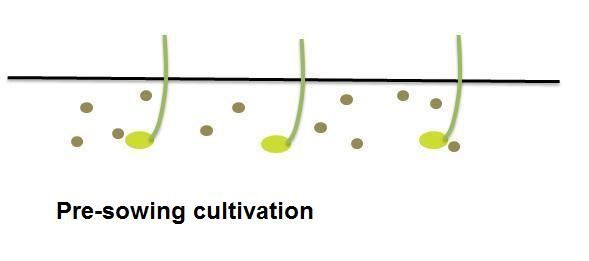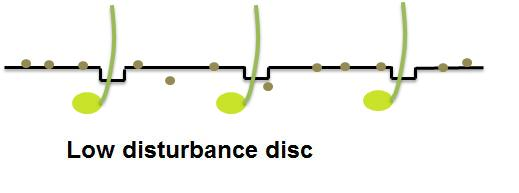Understanding pre emergent cereal herbicides
Understanding pre emergent cereal herbicides
Author: Christopher Preston, School of Agriculture, Food & Wine, University of Adelaide | Date: 04 Mar 2014
Christopher Preston, School of Agriculture, Food & Wine, University of Adelaide
GRDC code: UA00113, UA00134, UA00144
Take home message
The important factors in getting pre-emergent herbicide to work effectively while minimising crop damage are:
- to understand the position of the weed seeds in the soil; the soil type (particularly amount of organic matter and crop residue on the surface);
- the solubility of the herbicide; and
- its ability to be bound by the soil.
Understanding pre-emergent herbicides
With the increasing incidence of resistance to post-emergent herbicides across Australia, pre-emergent herbicides are becoming more important for weed control. Pre-emergent herbicides typically have more variables that can affect efficacy than post-emergent herbicides. Post-emergent herbicides are applied when weeds are present and usually the main considerations relate to application coverage, weed size and environmental conditions that impact on performance. Pre-emergent herbicides are applied before the weeds germinate and a number of other considerations come into play. The various pre-emergent herbicides behave differently in the soil and may behave differently in different soil types. Therefore, it is essential to understand the behaviour of the herbicide, the soil type and the farming system in order to use pre-emergent herbicides in the most effective way.
Pre-emergent herbicides have to be absorbed by the germinating seedling from the soil. To do so, these herbicides need to have some solubility in water and be in a position in the soil to be absorbed by the roots or emerging shoot. The dinitroaniline herbicides, such as trifluralin, are an exception in that they are absorbed by the seedlings as a gas. These herbicides still require water in order to be released from the soil as a gas. Therefore, weed control with pre-emergent herbicides will always be lower under dry conditions.
Behaviour of pre-emergent herbicides in the soil
Behaviour of pre-emergent herbicides in the soil is driven by three key factors:
- solubility of the herbicide,
- how tightly the herbicide is bound to soil components, and
- the rate of breakdown of the herbicide in the soil.
Characteristics of some common pre-emergent herbicides are given in Table 1.
The water solubility of herbicides ranges from very low values for trifluralin to very high values for chlorsulfuron. Water solubility influences how far the herbicide will move in the soil profile in response to rainfall events. Herbicides with high solubility are at greater risk of being moved into the crop seed row by rainfall and potentially causing crop damage. If the herbicides move too far through the soil profile they risk moving out of the weed root zone and failing to control the weed species at all. Herbicides with very low water solubility are unlikely to move far from where they are applied.
|
Herbicide |
Water solubility |
Koc |
Degradation half-life (days) |
||
|---|---|---|---|---|---|
| mg L-1 (at 20 C and neutral pH) | Rating | mL g-1 (in typical neutral soils) | Rating | ||
|
Trifluralin |
0.22 |
Very low |
15,800 |
Very high |
181 |
|
Pendimethalin |
0.33 |
Very low |
17,800 |
Very high |
90 |
|
Pyroxasulfone |
3.9 |
Low |
223 |
Medium |
22 |
|
Triallate |
4.1 |
Low |
3000 |
High |
82 |
|
Prosulfocarb |
13 |
Low |
2000 |
High |
12 |
|
Atrazine |
35 |
Medium |
100 |
Medium |
75 |
|
Diuron |
36 |
Medium |
813 |
High |
75.5 |
|
S-metolachlor |
480 |
High |
200 |
Medium |
15 |
|
Triasulfuron |
815 |
High |
60 |
Low |
23 |
|
Chlorsulfuron |
12,500 |
Very High |
40 |
Low |
160 |
Herbicides with greater water solubility typically need less soil moisture to be activated for absorption by the germinating seed. However, other soil factors, such as pH and soil organic matter, can have a major effect on herbicide availability.
Pre-emergent herbicides may be bound by soil components. Clay components can bind some herbicide, but the main component responsible for binding of pre-emergent herbicides is soil organic matter. The higher the soil organic matter content, the more herbicide will be bound. Australian cropping soils are typically low in soil organic matter by world standards and too much herbicide availability in the soil is more of a problem in Australia. Table 1 gives binding characteristics for some pre-emergent herbicides. The values are for the Koc, the soil organic carbon-water partitioning coefficient. High Koc values mean that more herbicide will be bound to organic matter and less herbicide will be available to move in the soil solution. Koc values for pre-emergent herbicides in Table 1 range from very high for trifluralin and pendimethalin to low for triasulfuron and chlorsulfuron.
The third factor is the rate of degradation of the herbicide in the soil. Herbicides can be chemically degraded in the soil, but more commonly they are degraded by microbes. Soil microbes require water and organic matter to be effective at degrading herbicides. The half-life of some common pre-emergent herbicides are given in Table 1. The half-life is the time it takes for half the original amount of the herbicide to be degraded. For example, prosulfocarb with a half-life 12 days will have 50% of the originally applied concentration left after 12 days, 25% after 24 days and 12.5% after 36 days. Long half-lives for herbicides typically mean long residual periods. Chlorsulfuron with a half-life of 160 days will have a longer re-cropping period than will triasulfuron with a half-life of 23 days.
Half-life is not necessarily a good predictor of the effective period of residual weed control. Weed control is achieved when the concentration of herbicide the germinating seed encounters is sufficient to stop the weed from emerging or to incapacitate it after emergence. If the rate of herbicide originally applied is much greater than that required to control the weed, then considerable effective persistence of the herbicide can be achieved even with a short half-life. Likewise, if the rate of herbicide originally applied is only just higher than required to control the weed, then effective persistence will be relatively short.
Soil properties other than organic matter and clay content can also influence behavior of herbicides. The most important of these in Australia is soil pH, particularly with sulfonylurea herbicides. At high pH these herbicides become more water soluble and tend to move further in the soil profile as well as binding less to soil organic matter. This can result in sulfonylurea herbicides moving out of the root zone. High pH also reduces the breakdown of of sulfonylurea herbicides by hydrolysis reactions, resulting in much longer persistence in the soil.
Some examples
With the foregoing information it is possible to make some broad predictions about the behaviour of pre-emergent herbicides under specific conditions. Trifluralin, for example, has very low water solubility and very high binding to organic matter. This means trifluralin will tend to stay where it is applied. Risks of damage to crops by trifluralin will occur when the crop is sown too shallow, resulting in insufficient separation between crop seed and the herbicide, or where soil containing the herbicide is moved into the crop row.
S-metolachlor (Dual Gold) has high water solubility and medium binding to organic matter in the soil. Therefore, this herbicide will readily move in the soil. Damage to sensitive crops, such as wheat, is more likely to occur in sandy soils with low organic matter and after heavy rainfall.
Pyroxasulfone (Sakura) has low water solubility, but does not bind strongly to organic matter. It is less likely to move through soil than S-metolachlor, but will do so in soil with low organic matter and can lead to crop damage under these circumstances. Due to its low water solubility, pyroxasulfone is best suited to situations where it is applied directly on top of the weed seed.
Cultivation and crop seeding systems
Pre-emergent herbicide behaviour is also influenced by soil preparation and the type of seeding system. Pre-emergent herbicides (other than triallate) are taken up by germinating seedlings through the roots or roots and mesocotyl (the part of the shoot immediately above the seed). Therefore, weed seeds will most likely absorb herbicide if the herbicide is at or below the seed in the soil profile.
At the end of the season, seed rain falls mostly on the surface of the soil. Some weed species, such as wild oats, have the ability to bury themselves into the surface of the soil, but most will remain on, or close to the soil surface. The aim with pre-emergent herbicides is to have as high a concentration of herbicide as possible where the weed seeds are positioned while minimising the amount of herbicide that reaches the crop seed. As a general rule, pre-emergent herbicides will be most effective if applied directly to the weed seeds. This has implications for the type of tillage and seeding equipment used with pre-emergent herbicides.
Cultivation prior to applying pre-emergent herbicides mixes the seed throughout the soil profile to the depth of cultivation (Figure 1). Using pre-emergent herbicides with pre-sowing cultivation means the weed seeds are separated from the herbicide. In this circumstance, either the pre-emergent herbicide has to be incorporated into the soil mechanically, or by rainfall or irrigation. As the weed seeds are spread through a greater volume of soil, the herbicide concentration will be more dilute at the weed seeds. Where the herbicide can cause crop damage, the crop seed needs to be sown below the band of soil that may contain damaging concentrations of herbicides.

Figure 1. Distribution of weed seed in the soil profile with pre-sowing cultivation.
At the other extreme, low disturbance disc seeding equipment leaves the weed seed on the soil surface and the herbicide sitting on top of the weed seed (Figure 2). This type of seeding system is not appropriate for use with herbicides, such as trifluralin and pendimethalin, which require mechanical incorporation to be effective. Pre-emergent herbicides with greater solubility are more appropriate for disc seeding equipment. However, because there is limited separation between herbicide and crop seed, products with high intrinsic safety to the crop need to be used.

Figure 2. Distribution of weed seed in the soil profile with low disturbance disc seeding equipment.
Knife point seeding systems that throw soil out of the crop row and onto the inter-row are well suited to use with most pre-emergent herbicides (Figure 3). These systems have the advantage of being able to place the herbicide on top of the weed seed, to incorporate the herbicide with the soil moved from the crop seed row, and to create sufficient space between the crop seed and the herbicide to provide crop safety. However, as there is little herbicide left in the crop row, weeds are likely to emerge in the crop row.

Figure 3. Distribution of weed seed in the soil profile with knife point seeding systems.
Regardless of soil disturbance with seeding system, there are several other factors that need to be considered. Due to their very high binding to organic matter, herbicides such as trifluralin and pendimethalin will be bound to crop residue in stubble-retained systems. This is usually managed by increasing the application rate of these herbicides and/or removing some of the crop residue, through burning for example.
With respect to weed control, triallate behaves differently to other pre-emergent herbicides. This is because it is primarily absorbed by the emerging coleoptile rather than the roots. Therefore, triallate needs to be situated at or above the weed seed to be effective. In conventionally cultivated systems, triallate can be an effective wild oat herbicide. However, in direct drill no-till systems, wild oat seeds are too close to the surface, so triallate rates need to be increased to obtain control. An alternative is to mix trifluralin with triallate.
Due to its different action in the soil profile, addition of triallate to other grass pre-emergent herbicides generally results in increased levels of control. Essentially, the mixture allows weeds germinating both at the top of the soil profile and below the soil surface to be controlled.
Summary
The important factors in getting pre-emergent herbicides to work effectively while minimising crop damage are: to understand the position of the weed seeds in the soil; the soil type (particularly amount of organic matter and crop residue on the surface); the solubility of the herbicide; and its ability to be bound by the soil. Managing all these factors is complex, but some rules of thumb are:
- Soils with low organic matter are particularly prone to crop damage from pre-emergent herbicides (especially sandy soils) and rates should be reduced where necessary to lower the risk of crop damage.
- The more water-soluble herbicides will move more readily through the soil profile and are better suited to post sowing pre-emergent applications than the less water soluble herbicides. They are also more likely to produce crop damage after heavy rain.
- Pre-emergent herbicides need to be at sufficient concentration at or below the weed seed (except for triallate which needs to be above the weed seed) to provide effective control. Keeping weed seeds on the soil surface will improve control by pre-emergent herbicides.
- High crop residue loads on the soil surface are not conducive to pre-emergent herbicides working well as they keep the herbicide from contact with the seed. More water soluble herbicides cope better with crop residue, but the solution is to manage crop residue so that at least 50% of the soil surface is exposed at the time of application.
- If the soil is dry on the surface, but moist underneath there may be sufficient moisture to germinate the weed seeds, but not enough to activate the herbicide. Poor weed control is likely under these circumstances. The more water soluble herbicides are less adversely affected under these conditions.
- Many pre-emergent herbicides can cause crop damage. Separation of the product from the crop seed is essential. In particular care needs to be taken with disc seeding equipment in choice of product and maintaining an adequate seeding depth.
Contact details
Christopher Preston
University of Adelaide
Ph: 08 8313 7237
08 8313 7237Email: christopher.preston@adelaide.edu.au
